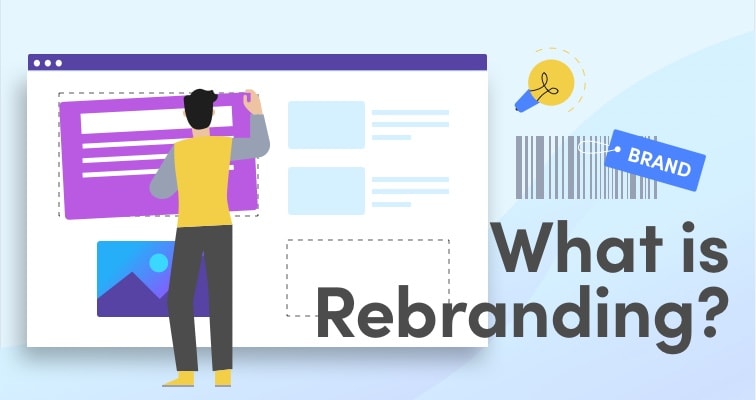Rebranding 101: When and How to Refresh Your Brand
In business, your brand is more than just a logo or a name. It is the image, reputation, and value people associate with your company. Over time, however, your brand might start to look outdated or no longer fit with your goals. When this happens, it might be time to think about rebranding.
Rebranding can help your business stay relevant, attract new customers, and grow. But knowing when and how to rebrand is important. Doing it at the wrong time or in the wrong way can hurt your business more than it helps.
In 2025, rebranding is more critical than ever. With consumers bombarded by choices and digital platforms like X, Instagram, and TikTok shaping perceptions, a stale or misaligned brand can get lost in the noise. According to a 2024 study by Statista, 74% of consumers say brand authenticity influences their purchasing decisions, and 59% are more likely to engage with brands that align with their values. A well-executed rebrand can:
-
Attract New Customers: A fresh look or updated messaging can appeal to untapped demographics.
-
Boost Trust and Loyalty: Modernizing your brand shows you’re adaptable and customer-focused.
-
Stay Competitive: A rebrand helps you stand out in saturated markets like e-commerce or tech.
-
Reflect Growth: As your business evolves, your brand should mirror your new vision or offerings.
This guide will explain the basics of rebranding. It will cover when to consider rebranding and how to do it the right way.
What is Rebranding?
Rebranding is a process where a business changes its brand to be different from what it used to be. This can include changing the company name, logo, design style, or even the way the business communicates.
Rebranding can be small and simple or big and complete. Sometimes it is just updating a logo or changing the marketing message. Other times, it might mean changing the company name, the product line, or the overall business strategy.
The goal of rebranding is to improve how people see your business. It helps you connect better with your target audience and stand out from competitors.
When Should You Rebrand?
Knowing when to rebrand is crucial. Rebranding too early or too late can cause problems. Below are signs that it might be time to refresh your brand:
1. Your Brand Looks Old and Outdated
If your branding feels stuck in the past or does not match current design trends, it might be time to update. A modern look can attract new customers and show that you are active and current.
2. Your Brand Does Not Represent Your Business Today
Sometimes, your business changes over time. Maybe you have added new products, entered new markets, or shifted your focus. If your current brand doesn’t reflect these changes, it is time to rebrand.
3. You Are Losing Customers or Facing Decline
If your sales drop and customers seem uninterested or confused about your business, your branding might be part of the problem. A fresh look and message can help re-engage your audience.
4. You Want to Enter New Markets
Expanding your business to new areas or customer groups can require a new brand identity. For example, a local store moving online or into international markets might need a new branding strategy.
5. Negative Reputation or Bad Image
If your brand has a bad reputation or is associated with negative feelings, rebranding can help distance your business from that image.
6. You Are Merging or Reorganizing
When two companies combine or you restructure your business, a rebrand often makes sense. It shows your new identity to customers and partners.
7. Your Brand Is Not Differentiating You from Competitors
If your brand looks like your competitors or does not stand out, it might be time to change how you look or what you stand for.
How to Rebrand the Right Way
Rebranding is more than just changing your logo or colors. It is a process that requires planning and strategy. Follow these steps to do it right:
Step 1: Define Your Purpose and Goals
Before making any changes, understand why you need to rebrand. Ask yourself:
- What are the main reasons for rebranding?
- What do we want to achieve?
- Who is our target audience?
Be clear about your goals. Do you want to attract new customers, enter new markets, refresh your image, or fix reputation issues?
Step 2: Do Market and Brand Research
Learn what your customers think about your current brand. Conduct surveys, interviews, or analyze online reviews. Find out what they like and dislike about your brand.
Study your competitors. See how they position themselves and what makes them different. This will help you find your own unique position.
Step 3: Develop a New Brand Strategy
Based on your research, decide what your new brand should stand for. Think about:
- Your brand’s purpose and values
- Your target audience
- Your brand message and voice
- Your visual identity (logo, colors, fonts)
Create a brand story that explains who you are, what you do, and why you do it. Make sure this story appeals to your target customers.
Step 4: Design Your New Visual Identity
Your visual identity includes your logo, color palette, fonts, and other design elements. These should reflect your new brand message.
Work with professional designers if needed. Keep it simple and memorable. Make sure your visual identity is flexible enough to use across different platforms like websites, social media, and packaging.
Step 5: Update All Brand Touchpoints
Rebranding doesn’t just mean a new logo. You need to update:
- Your website and social media profiles
- Business cards, packaging, and signage
- Advertising and marketing materials
- Employee uniforms or any uniforms
- Customer service templates
Consistency is key. Every point where customers interact with your business should reflect your new brand identity.
Step 6: Communicate the Change
Tell your customers and stakeholders about your rebrand. Explain why you are making the change and what it means for them.
Use email newsletters, social media, press releases, and your website. Be honest and transparent to build trust.
Step 7: Launch Your New Brand
Plan a launch event or campaign to introduce your new brand identity. This could be an online event, a special promotion, or a social media campaign.
Make it exciting and engaging. Show your customers what is new and why it is better.
Step 8: Monitor and Adjust
After the rebrand, keep an eye on customer feedback and how your brand is perceived. Use surveys or social media listening tools.
Be ready to make adjustments if needed. Sometimes, small tweaks can make a big difference.
Related Articles:
- Why a Brand Guide Is Essential for Every Nigerian Business who want to Win
- 10 Powerful Business Name Generators for Nigerian Entrepreneurs in 2025
- Why Every Ambitious Solopreneur Needs a Brand Manual in 2025
Tips for a Successful Rebrand
- Keep your core values and mission consistent, even if the look and message change.
- Involve your team in the process. Get feedback from employees and loyal customers.
- Be patient. Rebranding takes time to be accepted by your audience.
- Stay consistent in your messaging and design across all platforms.
- Use professional help if needed. Good design and clear messaging make a big difference.
Common Mistakes to Avoid
- Changing everything at once without a clear plan
- Not communicating enough about the change
- Ignoring customer feedback
- Focusing only on visual elements without a strategic purpose
- Trying to please everyone instead of your target audience
Conclusion
Rebranding is a powerful tool to grow and improve your business. It allows you to stay relevant, compete better, and connect with the right customers.
Remember, rebranding is not just about looks. It’s about real change in how people see and experience your business. When done carefully, it can lead to new opportunities and success.
If you notice your brand no longer reflects who you are or where you want to go, consider rebranding. Follow the steps in this guide, plan carefully, and communicate clearly with your audience. The right rebrand can give your business a fresh start and help you reach new heights.
Image source: Vitaldesign.com





